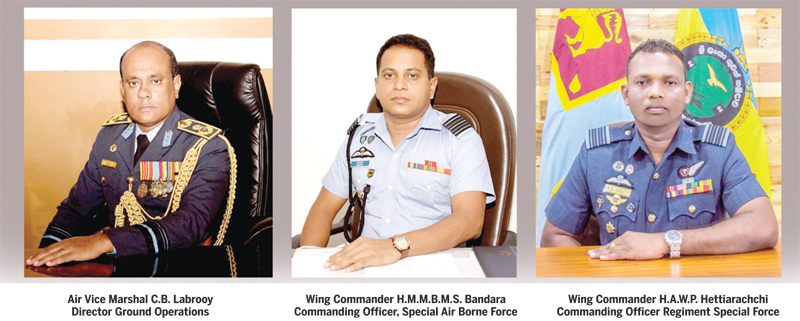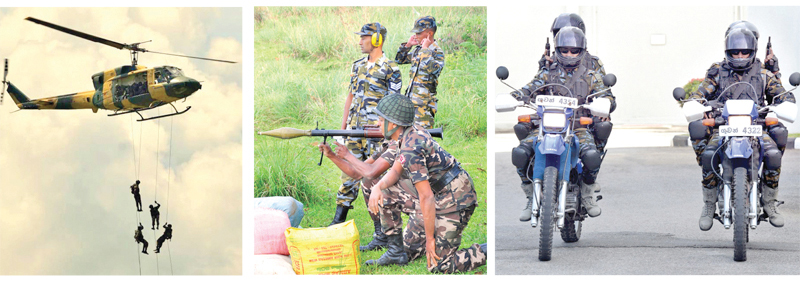Aircraft are synonymous with a nation’s Air Force. However there are many other sections which work behind the scenes to augment the overall role and task of the Air Force. Today we discover the great but silent contribution of the SLAF Regiment (also referred to as the Rock Apes) the largest component of the Sri Lanka Air Force (SLAF). Operating under the Directorate of Ground Operations, this command has 31 specialized regiment wings that have consistently enhanced the SLAF’s mission in achieving the overall national security objective.
I was privileged to meet the SLAF’s Director Ground Operations Air Vice Marshal Camillus Labrooy, at Air Force Head Quarters. The history of the airmen being deployed for ground operations can be traced back to 1956. During this era, two officers of the Royal Ceylon Air Force Regiment were trained in the United Kingdom. The unit was established at the SLAF Base in Katunayake. It is recorded that in 1961 there was a trade union strike at the harbour and the SLAF ground troops were called in to secure the area. During the 1971 insurgency the airmen were once again called upon to protect Temple Trees, the official residence of the Prime Minister.

During this time the first armoured personnel carrier (APC) from Ireland was inducted into the regiment. Subsequently six APCs were built locally under the supervision of a SLAF engineering officer. The new fleet enriched the “dismounted operations” capability of these pioneer SLAF defenders. In addition to these deployments the SLAF Regiment sustained the dignity and decorum of the Air Force by proudly undertaking ceremonial guard of honour parades. Even to this day they take their rotation with the ceremonial guard at President’s House, in Colombo.
 Air Vice Marshal Labrooy explained: “Once the international airport began operations at Katunayake the SLAF men were positioned for security duties. We have a rich heritage of providing security and securing the areas at the airport for many Heads of State over the decades. We handled the security at the airport for the Pope in 1970. During the 1976 Non-Aligned Summit in Sri Lanka the SLAF Regiment undertook an unprecedented security operation for almost 75 Heads of State and other VIPSs which was a tremendous task at that time.”
Air Vice Marshal Labrooy explained: “Once the international airport began operations at Katunayake the SLAF men were positioned for security duties. We have a rich heritage of providing security and securing the areas at the airport for many Heads of State over the decades. We handled the security at the airport for the Pope in 1970. During the 1976 Non-Aligned Summit in Sri Lanka the SLAF Regiment undertook an unprecedented security operation for almost 75 Heads of State and other VIPSs which was a tremendous task at that time.”
As the SLAF enhanced its aircraft fleet and established new bases and airfields, the SLAF Regiment also expanded.
Since the first armed insurgency in the 1970s, the security of all air assets fell on this dependable regiment. Two other significant additions in that era were the setting up of the SLAF Band (1970) and the formation of the SLAF Kennels (1978). To this day the air dogs engage in multiple roles with their handlers. As the SLAF entered the 1980s, it was going to face challenges. The 1983 riots which spread across the island saw the regiment’s troops being deployed to maintain law and order. Later on in 1988, the experienced airmen were tasked to secure Hambantota and Kegalle areas, which had a large concentration of JVP rebels.
The exigencies of service created the Explosives Ordnance Department in 1987 in Colombo, with an officer assuming the post of CXO (Command Explosives Officer). This was followed by the addition of the Air Defence Wing, which combined the use of radar input and anti-aircraft guns.
As the conflict took on a new dimension in the 1990s, the SLAF Regiment was called in to be deployed in large numbers, to fight alongside the Army in Maha Oya (Anuradhapura area) and Morawewa (along Trincomalee). The daunting task of keeping the Main Supply Route (MSR) open was thrust upon the SLAF ground troops. Having previously secured airfields and base facilities, it took a while for the airmen to adapt to their infantry role in the heavily wooded areas filled with mines. Those senior officers engaged in these duties will recall that the Horowpathana–Trincomalee road had the most concentration of concealed mines. Amidst challenges and ambushes, the gallant SLAF defenders pushed forward to keep the MSR lines open, enabling innocent civilians in those areas to receive essential supplies.
By 1997 the empowered troops of SLAF Regiment gallantly displayed their prowess by holding onto Forward Defence Lines (FDLs), which were initially secured by the Army. Some of the FDLs were spread across 50Km to 60Km in the Puliyankulam, Mankulam and Poovarasankulam areas and holding them also involved logistics support. Whilst the SLAF manpower was concentrated for these duties the remaining airmen played a vital role in the defence of Colombo. The Chemical, Biological, Radiological, Nuclear & Explosive Wing (CBRNE) was duly established by the Air Force to mitigate any future threats.
Birth of the RSF

When the threat of airfields and air assets was identified, the SLAF gave priority for the formation of specially trained commandos. The pioneer of Air Force commandos is the late Wing Commander Eksith Peiris. As a dynamic young Flight Lieutenant he began training a batch of men on February 25, 1979. In those formative years, the men proudly brandished their G-41rifles which had an effective firing range of 400 metres.
Wing Commander Peiris is fondly remembered as the founding father of a Special Forces element within the Sri Lanka Air Force. As the years went by the high command initiated the formation of ABDR Squadron (Air Base Defence and Rescue) with just 40 personnel. The squadron was established at SLAF Base Hingurakgoda on July 7, 2003.
The SLAFs MI-17 and MI-24 gunships were stationed here and had to be protected. Fighting in a jungle terrain is one thing but fighting to secure an airfield with its air assets requires specialized training.
The ABDR was subsequently transformed to be the Regiment Special Force (RSF). This is the formidable ground attack force of the SLAF with multi-role combat capability. In order to join the RSF officers and airmen must undergo a PT selection test. Aspiring recruits endure six months of intense training in all types of terrain.
The RSF also takes pride in its capacity to be deployed via parachutes by day or night in sunshine or rain. RSF commandos are also able to engage in rescue missions on land and water. Specialist courses promote parachutists to become skydivers. The basic fighting formation of the RSF is the eight-man team and their preferred weapon is the SAR-21. Robust warriors of this force can reach the ground from a helicopter by rappelling and enter a tower or building by abseiling. The RSF has its own divers increasing their spectrum of combat and rescue operations. The men have shared some of their motivational training by building teams from the corporate sector on request, enhancing their leadership skills.
The dynamic SABF

During the late 1980s service commanders and senior Defence Ministry officials were under threat from the LTTE. The Air Force realized this and took action. Air Vice Marshal Oliver Ranasinghe (later Air Force Commander) prepared a special group of five officers and 30 men. They were given intense training and excelled in small team raids. By 1994 having broadened their skills in Close Protection duties they became a shield around the Air Force Commander. This is the first team in Sri Lanka to introduce the concept of motorbike outriders in a security convoy. The SABF – Special Air Borne Force operates in four areas: VIP protection duties, anti- hijack operations, rescue operations and urban operations (military operations in urban terrain).
Joining the SABF is a challenge. Serving officers and airmen with four years of service can apply to join. They have to face a difficult 21-day selection test, at which some aspiring candidates are dropped out. The training requires mental and physical endurance, with the men having to wake up at 2.00 am before engaging in grueling PT. During the 21-days preliminary training at Ampara the men have to do 5Km, 10Km, 15Km and 25Km marches with full battle pack.
Those who survive proceed to Phase 2 where they learn unarmed combat and the dynamics of Close Protection duties for 60 days. Later on, the SABF personnel can augment their skills by doing the Combat Rider Course. Their special airborne capacity enables them to be inducted at a required target within the shortest time. The SABF can also operate as air marshals on civilian passenger flights if required. The men have shared some of their motivational training by building teams from the corporate sector on request, enhancing their leadership skills.
The SLAF Regiment was duly bestowed with the President’s Standards for their distinguished service to the nation on May 3, 2009. To this day the men of this regiment have undertaken security cover for schools, churches, hotels and diplomatic missions within the Colombo, Ratmalana and Negombo areas, after the deadly Easter Sunday attacks.
The SLAF Regiment can be proud of all its achievements and marches forward in defence of its assets and the nation under the guiding hand of the present Air Force Commander Air Marshal Sudarshana Pathirana.
